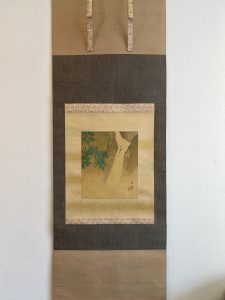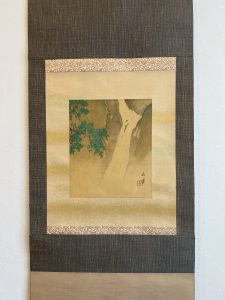川合玉堂の世界(愛知県名古屋市千種区姫池通 骨董買取 古美術風光舎)
2025.03.12
川合玉堂作【瀑布】

現在お店に飾っている軸は川合玉堂なのですが、川合玉堂は愛知県の出身ですので、ここ愛知県では玉堂の軸をお持ちの方もお見かけすることがあります。愛知県出身とはいえ彼のように地方を離れ、様々なご縁により出世魚のように色々なところで活躍する作家も多いですよね。
彼も上京し、昭和19年から昭和32年に亡くなるまでの10余年は青梅市御岳で過ごし、現在はそちらに玉堂美術館が立てられているようです。
このようにゆかりの地を巡っていくと作者の痕跡を辿ることが出来る美術館も日本全国を巡ることがちょっと好きなので立ち寄ることがあるのですが、玉堂美術館は如何せん青梅市。いつか訪れてみたいのですが気合がいりそうです笑。
さてさて川合玉堂(1873年(明治6年)11月24日生)ですが、詳しくが愛知県葉栗郡外割田村(現在の一宮市)に筆墨紙商の長男として生まれました。子供の頃から周りに筆や墨や紙が身近にあった環境だったんですね。
幼少期から美術に親しんでいた玉堂は、12歳頃から本格的に絵を学び始めますが、14歳の時、京都の望月玉泉の門下に入り「玉舟」の号を与えられます。その後17歳で幸野楳嶺に師事し四条派を学びます。この年、第3回内国勧業博覧会に「春渓群猿図」と「秋渓群鹿図」を出品し入選。これを機に号を「玉堂」と改めました。
23歳で上京した玉堂は、狩野派の橋本雅邦の門下に入ります。雅邦の影響を強く受けた玉堂は、四条派と狩野派の画法を融合させた独自の画風を確立していきました。
1898年(明治31年)には、岡倉天心や横山大観らが創立した日本美術院に当初より参加。1907年(明治40年)には第1回文展(文部省美術展覧会)の審査員に任命され、1915年(大正4年)からは東京美術学校(現在の東京藝術大学)日本画科の教授に就任するなど、日本画壇の中心的存在となっていきます。また、玉堂の才能は国内外で高く評価され、1931年(昭和6年)にはフランスのレジオンドヌール勲章を受章。1940年(昭和15年)には日本の文化勲章を受章しています。
そして、第二次世界大戦中は東京都西多摩郡(現在の青梅市)に疎開し、終戦後もその地に定住することとなります。自然に囲まれた環境で制作を続けました。1957年(昭和32年)6月30日、83歳でその生涯を閉じるまで、玉堂は日本の自然美を描き続け、現在は「⽟堂美術館」として、15歳から絶筆となる84 歳の作品まで、幅広く展⽰を⾏っているようです。
川合玉堂の作品を見ると、どのような感覚を覚えますか?多くの人は、日本の原風景を目の当たりにしているような感覚に陥るといいます。
川合玉堂の作品の最大の魅力は、日本の四季折々の自然と、そこに生きる人々や動物たちの姿を、優美な墨線と繊細な色彩で描き出したことにあります。
国立近代博物館にある「行く春」(重要文化財)を拝見したことがあったのですが、とても大きな画なのですが、その表現も、繊細でありでも大胆であるといった印象でありました。また、穏やかではありますが色彩がとても印象的で、そこも繊細であり大胆さを感じました。
そして、こちらの「瀑布」。こちらは小さな軸なのですが、玉堂の繊細と大胆さがぎゅっと詰まっている印象でありました。画が大きいが小さいかは一旦置いておいても、その魅力は同じな気がしました。
それではごきげんよう。(スタッフY)

Waterfall” by Gyokudo Kawai
The axis currently displayed in our store is by Gyokudo Kawai, but since Gyokudo Kawai is from Aichi Prefecture, you may see some people here in Aichi Prefecture who own Gyokudo’s axes. Even though he was born in Aichi Prefecture, there are many artists like him who left the countryside and became active in various places like a rising fish due to various connections.
He also moved to Tokyo and lived in Mitake, Ome City for more than 10 years from 1944 until his death in 1957, where the Gyokudo Museum is now located.
I sometimes stop by at museums where I can trace traces of the artist as I visit places associated with him, as I like to travel around Japan, but the Gyokudo Art Museum is located in Ome City. I would like to visit there someday, but it would take a lot of energy.
Gyokudo Kawai (born November 24, 1873) was the eldest son of a brush and ink merchant in Sotowariden Village, Haguri County (present-day Ichinomiya City), Aichi Prefecture. He was in an environment where brushes, ink, and paper were around him from childhood.
Gyokudo, who was familiar with art from his childhood, began to study painting in earnest around the age of 12, and at the age of 14, he entered the school of Mochizuki Gyokusen in Kyoto and was given the name “Gyokusyu”. Later, at the age of 17, he studied under Kouno Umelei and learned the Shijo school. In the same year, he exhibited “Shunkei Gundansaru” and “Shukei Gunda” at the 3rd National Industrial Exhibition, which were selected. He took this opportunity to change his name to Gyokudo.
At the age of 23, Gyokudo moved to Tokyo and became a student of Hashimoto Gaho of the Kano school. Strongly influenced by Gaho, Gyokudo established his own style of painting that combined the painting methods of the Shijo School and the Kano School.
In 1898, Gyokudo joined the Nihon Bijutsu-in (Japan Art Institute), founded by Okakura Tenshin and Yokoyama Taikan, and in 1907, he was appointed as a juror for the first Bunten (the art exhibition of the Ministry of Education), and in 1915, he became a professor of Japanese painting at the Tokyo Fine Arts School (now Tokyo University of the Arts). Gyokudo became a central figure in the Japanese art world. In 1931, Gyokudo was awarded the French Legion of Honor, and in 1940, he received the Japanese Order of Cultural Merit.
During World War II, he was evacuated to Nishitama-gun, Tokyo (present-day Ome City), and settled there after the war. He continued to work in an environment surrounded by nature, and until his death on June 30, 1957, at the age of 83, Gyokudo continued to depict the natural beauty of Japan.
What kind of feeling do you get when you see Gyokudo Kawai’s works? Many people say that they feel as if they are witnessing the original landscape of Japan.
The greatest appeal of Gyokudo Kawai’s works lies in his depiction of Japan’s seasonal nature and the people and animals that live there, with graceful ink lines and delicate colors.
I once saw “Going Spring” (Important Cultural Property) at the National Museum of Modern Art, and although it is a very large painting, its expression is both delicate and bold. It is a very large painting, but its expression is both delicate and bold.
And then there is this “Waterfall”. Although this is a small scroll, I had the impression that Gyokudo’s delicacy and boldness were all packed into it. Whether the painting is large or small, I felt that the charm of the work is the same.
Good day to you. (Staff Y)

